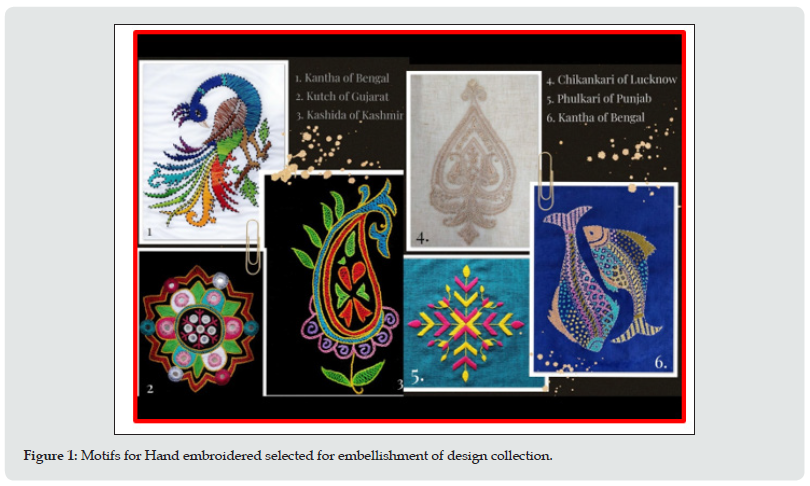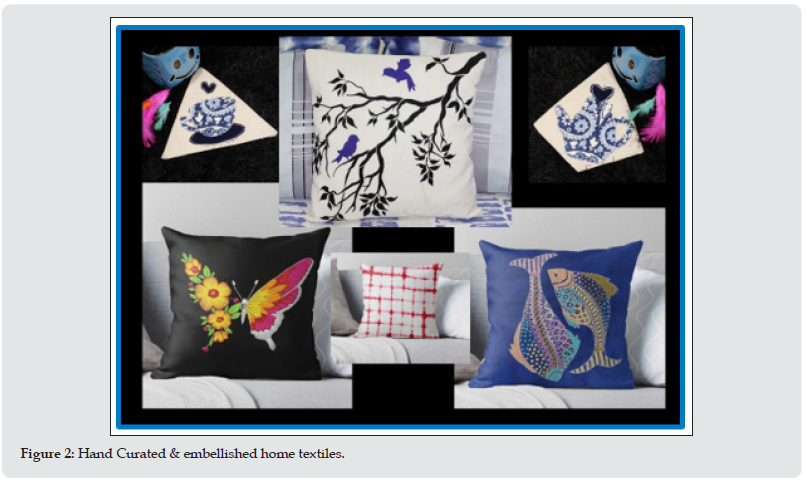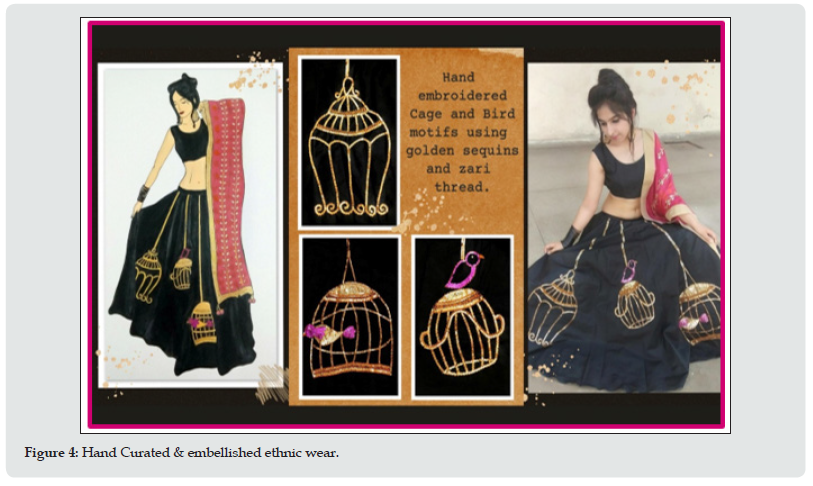
Lupine Publishers Group
Lupine Publishers
Menu
ISSN: 2637-4595
Review Article(ISSN: 2637-4595) 
Rebooting Post Pandemic Fashion by Endorsing Vocal for Local Volume 4 - Issue 4
Yamini Jhanji* and Aditi Hooda
- Department of Fashion & Apparel Engineering, The Technological Institute of Textile & Sciences, India
Received:January 22, 2022 Published: January 31, 2022
*Corresponding author: Yamini Jhanji, Department of Fashion & Apparel Engineering, The Technological Institute of Textile & Sciences, India
DOI: 10.32474/LTTFD.2022.04.000193
Abstract
The unprecedented and hapless pandemic situation has deleteriously affected the textile and fashion industry. The interrupted supply chain due to workforce migration and unavailability, rejections of global export orders, consumers’ reluctance to spend on fashion, prolonged closure of outlets during lockdowns and declining foot fall have hardly hit the manufacturers, retailers and stakeholders. However, the industry portrayed a strong face amidst difficult times transforming their business models and switching over from fast fashion to slow, sustainable fashion, endorsing indigenous, local goods and manufacturing essentials and functional entities like face masks and PPE kits. The ardent need of current times for rebooting the fashion industry and averting any pandemic aftermaths is following the concept of sustainability and vocal for local in the textile and fashion supply chain. The endorsement of traditional textiles and hand curated Indian handicrafts by designers can go a long way in upliftment of artisans and improving the country’s financial configuration. The present paper suggests design and development of traditional, hand curated apparels, accessories and home decor as a means to reboot the fashion industry and enhanced competitiveness and liking among consumers over highly priced goods of expatriate origin and to promote indigenous handicrafts. Accordingly, design collection Desi Treasure comprising of assortment of hand curated home decor, apparels and accessories embellished with varied surface ornamentation techniques was developed with an indent to promote traditional textiles and artforms. The design inspiration for the collection was garnered from artisans and indigenous craftsmen. The highlights of collection included the usage of vibrant colors, flaura and fauna, geometrical patterns inspired motifs and hand curated ensembles.
Keywords: Fashion; sustainable fashion; supply chain; indigenous; craftsman; artisans; textiles; handicrafts; hand embroidery
Introduction
The diversity and magnificent aura of Indian traditional textiles and the pristine craft forms is acknowledged globally with many mainstream, high end designers recreating the splendor of indigenous art forms in their runway collections. The exquisite aesthetics, uniqueness, touch, feel and charm of hand curated fine workmanship by artisans and craftsperson narrate the story of their splendor and enriched heritage in the developed end products like apparels, accessories and home textiles. Have said all that, the artisans and craftsmen still struggle to meet both ends meet and are forced to switch over to other employment avenues will minimal growth and promotion avenues in their native domains. The ardent need is thus lucrative association of designers with artisans and craftsmen to ensure that age old, pristine and rich heritage does not die out on account of no takers of their art forms on domestic platforms. Since time immemorial, there have been movements and clamor to support the cause of skilled yet under privileged workforce, uplift their social and economic stature, fostering self-reliance encouraging them to pass their rich legacy to future generations and provide a holistic showcasing platform for their fine workmanship. Undoubtedly, apart from designers and manufacturers, the consumers can also play their part in supporting the indigenous artisans and craftsmen by giving precedence to home grown, indigenous and local artisanal brands and design collections over luxury and high-end international brands [1- 5]. The concept of Vocal for local can be imbibed and practically implemented when consumers develop pungent for domestically developed artisanal ensembles and are wary to make deliberate purchases to support local artisans and craftsmen. Consequently, the Indian craftsmen hold a fair chance not to earn a means of livelihood without thinking of alternate career avenues but also to showcase their skills, artforms thereby preventing the gradual dyeing out of the art forms connected to our roots.
Modern eras have witnessed common vested aspirations and interests of consumers towards experimental and unconventional fashion as a means to stay connected to their roots and heritage. The Indian craft clusters has been instrumental to cater to the likes and aspirations of fashion connoisseurs transcending demographic boundaries by amalgamation of incredible and exclusive skill, heritage and dynamism. Nevertheless, the experimental and vanity fashion has been hardly hit, slowing down the markets and big retails that affect clusters of craft and indigenous artforms in unprecedented pandemic times. A drastic shift in consumers buying behavior has been observed in the current scenario. The unpleasing layoffs, increased unemployment and toll on country’s economic growth have all instilled a feeling of insecurity among the masses. Accordingly, consumers have been refraining themselves from mindless shopping and have been more watchful of quantities they buy and the ecological impact of their purchases [6-9]. The struggling and hapless plight of country’s workforce cannot be undermined who had been forced to migrate to their native places and countryside owing to country wide lock downs and shutting down of major industrial establishments. The nationwide clamor and empathy towards blue collared workers, artisans and craftsmen fostered the designers to step forward and stand out for indigenous artisans and craftsmen ensuring that each artisan could at least earn their bread and butter if not lavish income sources. The ardent need of the hour is thus endorsement of indigenous craftsmanship and traditional textiles by re-creation of the techniques with modern/contemporary design aesthetics to support the artisans and workforce financially and providing a larger audience and global markets for their hand curated end products.
Designers have been proactive in supporting artisans and craftsmen by associating with them for their runway collections showcasing foray of traditional and had crafted ensembles.
Designers have been blending traditional artforms and techniques with modern sensibilities for creation of exquisite contemporary wear. Accordingly, the combined efforts and association of designers and budding entrepreneurs with artisans have brought spotlight on rich Indian heritage, art, tradition and textiles reviving the techniques in their recurring styles as well. Additionally, a sustained source of employment and livelihood to artisans along with opportunity to showcase their unparalleled skills internationally is ensued by lucrative collaboration. High end designers like Manish Malhotra, Anita Dongre, Rahul Mishra and Anavila Misra, Rina Singh and Gautam Gupta have been instrumental in working hand in hand with artisans thereby launching exclusive design collections that speak volumes about rich heritage of traditional textiles and hand curated workmanship.
a) Designer Manish Malhotra have been doing so for a while now, he supports hundreds through his Project Mijwan.
b) Anita Dongre works very closely with SEWA artisans for Aari work from different villages for Soi Bharat. Soi Bharat work is instantly recognizable by its nature-inspired motifs and beautiful craftsmanship.
c) Designer Rahul Mishra, couture felt like a ray of hope and faith. He believes that the collection united them as they started creating at the safety of their homes. The core idea behind his latest “Butterfly People” collection was to cultivate sustainable employment for the craft community.
d) Designer and many more have been standing by the artisans.
Design & development of traditional design collection - Desi Treasure
Design collection “Desi Treasure” comprising of assortment of hand curated home decor, apparels and accessories embellished with hand embroidery, applique work, patch work, tie & dyeing, hand painting was developed with an indent to promote traditional textiles and artforms. The design motivation for the collection was inspired from artisans, local dyers and indigenous craftsmen. Every stitch and knot were strongly related to the present and future of an artisan, especially hit by the pandemic. The highlights of collection included the usage of vibrant colors, nature inspired motifs, flaura and fauna, geometrical patterns and hand curated ensembles. Figures 1-4 shows the hand curated design collection embellished with varying surface ornamentation techniques. A variety of fabrics like cotton, velvet, tafetta, viscose rayon, shantoon and georgette were chosen as base material for surface embellishment and making up of articles. The chosen embellishment technique was hand painting, tie & dyeing, hand embroidery. Hand embroidery was accomplished by utilizing vibrant coloured, two plied or single plied cotton, silk, zari embroidery threads, sequins, and mirrors. The stitches chosen for motifs comprised of running stitches, satin stitches, blanket stitches, chevron stitches, honeycomb stitches, fishbone stitches, bullion knots, French knots, eyelets, saltwork etc. that are traditionally used. Tie & dyeing was accomplished by first tying the fabric in a predetermined pattern and then dyeing using natural ingredients. Hand Painting was accomplished by painting motifs inspired from nature by hand on the textile surface. The inspiration for motifs was garnered from artisans and indigenous craftsmen who peruse this traditional art form as means of their livelihood. Motifs inspired from traditional embroideries of India like Kantha of Bengal, Kutch of Gujarat, Kashida of Kashmir, Chikankari of Lucknow, Phulkari of Punjab etc. using traditionally used materials, techniques and motifs (Figure 1). Figure 2 shows the developed home décor artifacts like cushion covers, tea coasters etc. embellished by hand painting, tie & dyeing, hand embroidery, patch work inspired from traditional art forms. The design collection also comprised of hand curated embellished fashion accessories as shown in Figure 3. Traditional apparels were designed and embellished using traditional techniques like hand embroidery inspired from indigenous crafts using embroidery threads, zari threads, sequins, beads, mirrors etc (Figure 4). The embellished ensembles were rated by respondents subjectively in terms of aesthic and visual appeal. The subjective trials suggested that respondents preferred the home decor and apparels embellished with hand embroidery.
Conclusion
The pandemic era has been a learning experience for designers and consumers alike to revamp their design collection and wardrobe. The transition towards local and indigenous hand curated articles is the need of the hour to support artisans and strengthen the weakening economy. The design collection - Desi Treasure comprising of hand embellished apparels, accessories and home decors was designed with the objective to pay tribute to local artisans and strengthening the concept of “Vocal for Local”. The subjective evaluation of the design collection suggested that the motifs chosen for embroidery and the assortment of end articles was likeable by the respondents.
References
- Sabiha Khatoon, Ayesha Iffat (2021) Research Journal of Textile and Apparel.
- Malcolm Benjamin (1994) International Trade Forum p. 16
- Y Jhanji (2021) Design & Development of Traditional & Sustainable Contemporary Women Wear. Latest Trends in Textile and Fashion Designing Research 4(2): 737-742.
- https://www.hamstech.com/fashion-design-learn-more-about-surface-ornamentation
- Yamini Jhanji (2017) Deepika Grewal, Revival of Madhubani Painted Textiles.
- Yamini Jhanji Dhir (2020) CAD intervention for Revival, Stylization & Adaptation of Madhubani Traditional Textiles. International Journal for Modern Trends in Science and Technology 6(8): 145-148.
- https://www.iknockfashion.com/butterfly-people-by-rahul-mishra#:~:text=To%20Rahul%20Mishra%2C%20couture%20felt,employment%20for%20the%20craft%20community
- https://www.hindustantimes.com/fashion-and-trends/the-fashion-industry-goes-vocal-for-local/story-EgbTF1DQeCFt7m1B6yXV1J.html
- https://m.timesofindia.com/life-style/fashion/buzz/go-vocal-for-local-in-fashion/articleshow/80363655.cms

Top Editors
-

Mark E Smith
Bio chemistry
University of Texas Medical Branch, USA -

Lawrence A Presley
Department of Criminal Justice
Liberty University, USA -

Thomas W Miller
Department of Psychiatry
University of Kentucky, USA -

Gjumrakch Aliev
Department of Medicine
Gally International Biomedical Research & Consulting LLC, USA -

Christopher Bryant
Department of Urbanisation and Agricultural
Montreal university, USA -

Robert William Frare
Oral & Maxillofacial Pathology
New York University, USA -

Rudolph Modesto Navari
Gastroenterology and Hepatology
University of Alabama, UK -

Andrew Hague
Department of Medicine
Universities of Bradford, UK -

George Gregory Buttigieg
Maltese College of Obstetrics and Gynaecology, Europe -

Chen-Hsiung Yeh
Oncology
Circulogene Theranostics, England -
.png)
Emilio Bucio-Carrillo
Radiation Chemistry
National University of Mexico, USA -
.jpg)
Casey J Grenier
Analytical Chemistry
Wentworth Institute of Technology, USA -
Hany Atalah
Minimally Invasive Surgery
Mercer University school of Medicine, USA -

Abu-Hussein Muhamad
Pediatric Dentistry
University of Athens , Greece

The annual scholar awards from Lupine Publishers honor a selected number Read More...








